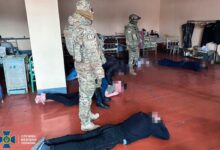Against the backdrop of the Kremlin's nuclear weapons chatter, advice on how to minimize the likelihood of lethal consequences has become relevant again.

The Kremlin rattles nuclear weapons again, The EU High Representative calls for Putin's recent nuclear threats to be taken seriously, President Zelensky also believes that the words of the leader of an enemy country are not a bluff.Against the background of new realities, advice on how to assemble a “nuclear alarm backpack” and what to do in the event that a strike does occur began to appear on the network.
“Let's start with what to collect… All things must be packed either in plastic bags or kept in the original sealed packaging. This is important!”, – notes Roman Pavlyuk from Intellias Ukraine, who tried to “gather his experience from classes in TSO (civil defense – ed.), physics, in particular nuclear”.
One of the basic but easy things to implement is to carry a sealed FFP2/3 mask, preferably two. It weighs 10 grams and can be “spread out in the pockets of all jackets”.
Read also: Atomic Fracture
However, what does the “alarming nuclear backpack” consist of? >
1. Two sets of comfortable pants, preferably military pants, as they are made of dense semi-synthetic fabric.
2. 5 pcs. polyethylene raincoats
3. 5-10 pairs of overshoes, maybe medical ones.
4. A roll of garbage bags, preferably thicker.
5. 6 pcs. Respirators FFP2, and even better FFP3. “Recommended by our production. Each in a separate package!”
6. Scotch tape, perfectly reinforced, in fact any
7. 4 pairs of rubber household gloves
8. 1 piece of work glasses, such as for working with a grinder
9. 3 packs of paper napkins
10. 2 bottles of nail polish remover (acetone)
11. 3 liters water in a polyethylene container. The thicker the walls, the better.
12. The compass is mechanical. Precisely mechanical, not on the phone.
13. Terrain maps are either purchased or printed from the Internet. A pencil, pen included.
14. And the most important thing: a Geiger counter, or a radiation detector. We buy it one per family. Naturally, you should also take care of the power bank and/or batteries for it.
15. (Optional) Radio receiver, necessarily with CX/X range. However, we assume that there will be no communication with the central station, as it will be destroyed in the explosion.
What to do immediately after nuclear alert?
First of all, you need to take all the above items and move into the room as deep as possible, at least the basement. If the impact is on the street, a gap, a hole, and something like that will agree.
It is important to get rid of metal devices, in particular gadgets, electronics. At least keep them away from the body. When the impact occurred, it is better to lie down on the floor, face down, cover your eyes with your hands.
Read also: Negotiations on the creation of a nuclear safety zone at the Zaporizhzhia NPP have moved from place to place – Raphael Grossi
Nuclear detonation can be: ground, air, underground, and high-altitude. They have a different radius of damage and severity of impact on the body. If it is even a ground strike, then in a reliable hiding place it is quite likely to be survived without immediate fatal consequences:
“In a deep basement, for example, on -2, -3 floors and further, a nuclear strike can be survived even in the epicenter, if the detonation is airborne. Therefore, it is not worth saying that the epicenter is 100% death. And you should always hide, even if you suddenly know that a “nucleus” is definitely flying in your area.
Read also: The UN Secretary General called for an end to the “epoch of nuclear blackmail”
Explosion: further actions
“Shock, explosion… we are waiting for everything to die down and calm down, that is, the shock wave will pass and we will begin evacuation. If you haven't collapsed and you have a nuclear backpack, then we will proceed according to the plan,” Pavlyuk's message says, and he offers the following algorithm of actions:
1. Put on an FFP3 mask.
2. Put on gloves
3. We put on a raincoat
4. We put on glasses and shoe covers
5. We wrap and seal with tape where possible, as if we are making a homemade OZK suit (universal military protective kit – ed.)
“And remember: first we put on protection, and then dosimeters and everything else.
Now two scenarios: if you have a supply of water-food, you are in a safe shelter, but you do not have a dosimeter and the protective equipment described above, I advise you to stay there for the next 12-24 hours, since you do not know where it is more dangerous — inside or outside. Even while staying inside, try to protect the respiratory organs with what is at hand – a gauze bandage, clothes (clean!), a medical mask, a shawl, and so on. After 24 hours, we leave and go to the evacuation”.
However, it may not always be appropriate. About how to last 2 days, which, in the best case scenario, will be enough to evacuate from the zone of total danger (this 4-5 km.) and more detailed advice – read in the post.
Related video
As a reminder, the Eurasian Center of the Atlantic Council believes that playing the nuclear card is Putin going crazy.
See special topic: The impunity of the Russian Federation after the war will disappoint Ukrainians more than poverty and corruption – survey More than half of the residents of our country chose this answer. Who blew up Nord Stream and why? I would like a detective from Agatha Christie, but it looks like Dontsova < /span> Sleeping on concrete, “rods down” and constant beatings: the ombudsman told how the Russians abused Ukrainian prisoners They gave very little food and water. EBRD has worsened the forecast for the recovery of Ukraine's economy Financial institutions' expectations are becoming increasingly pessimistic due to the duration of the war Mobilization in Ukraine: is it legal to serve summonses in public places The law does not prohibit it.



